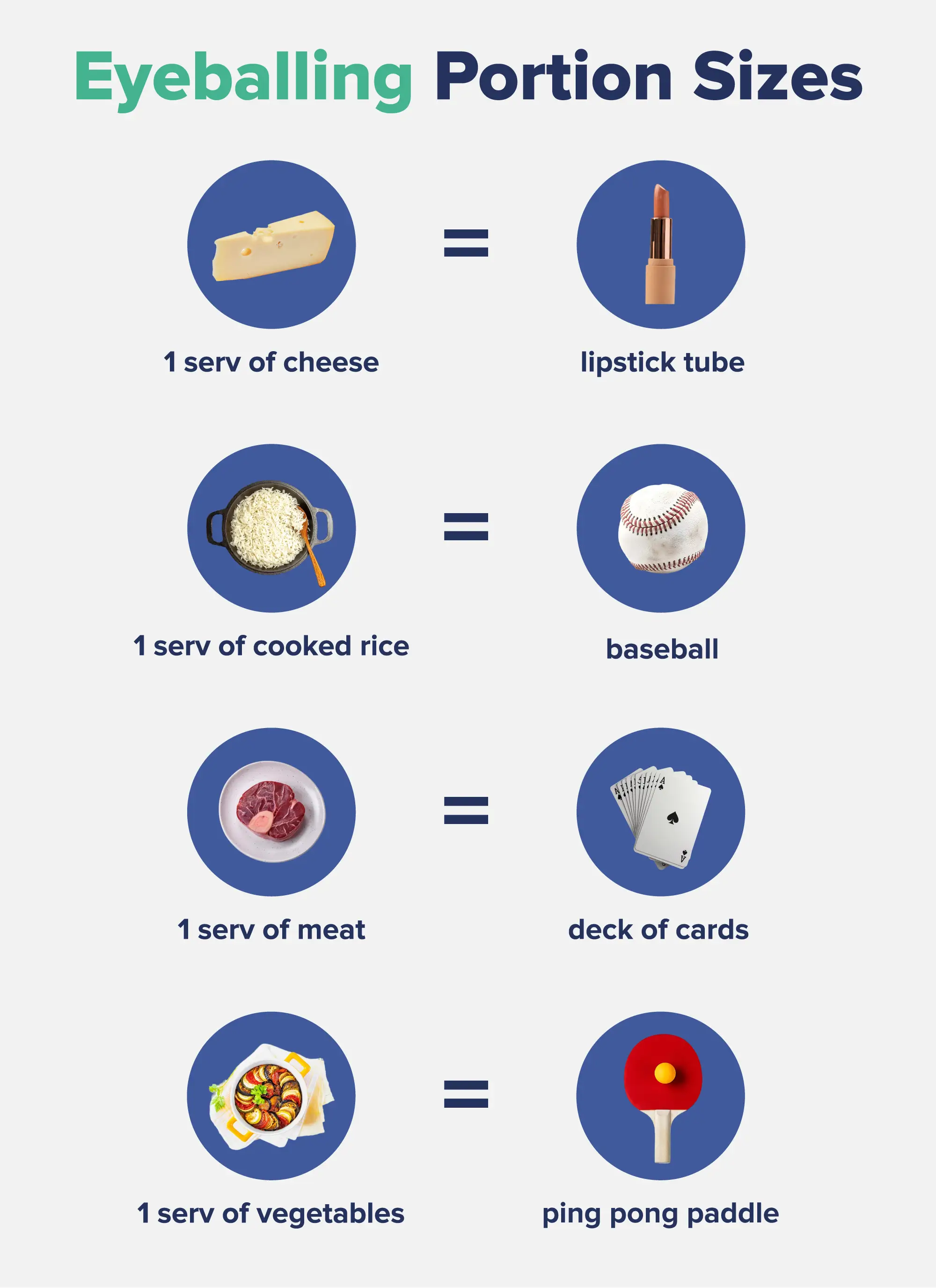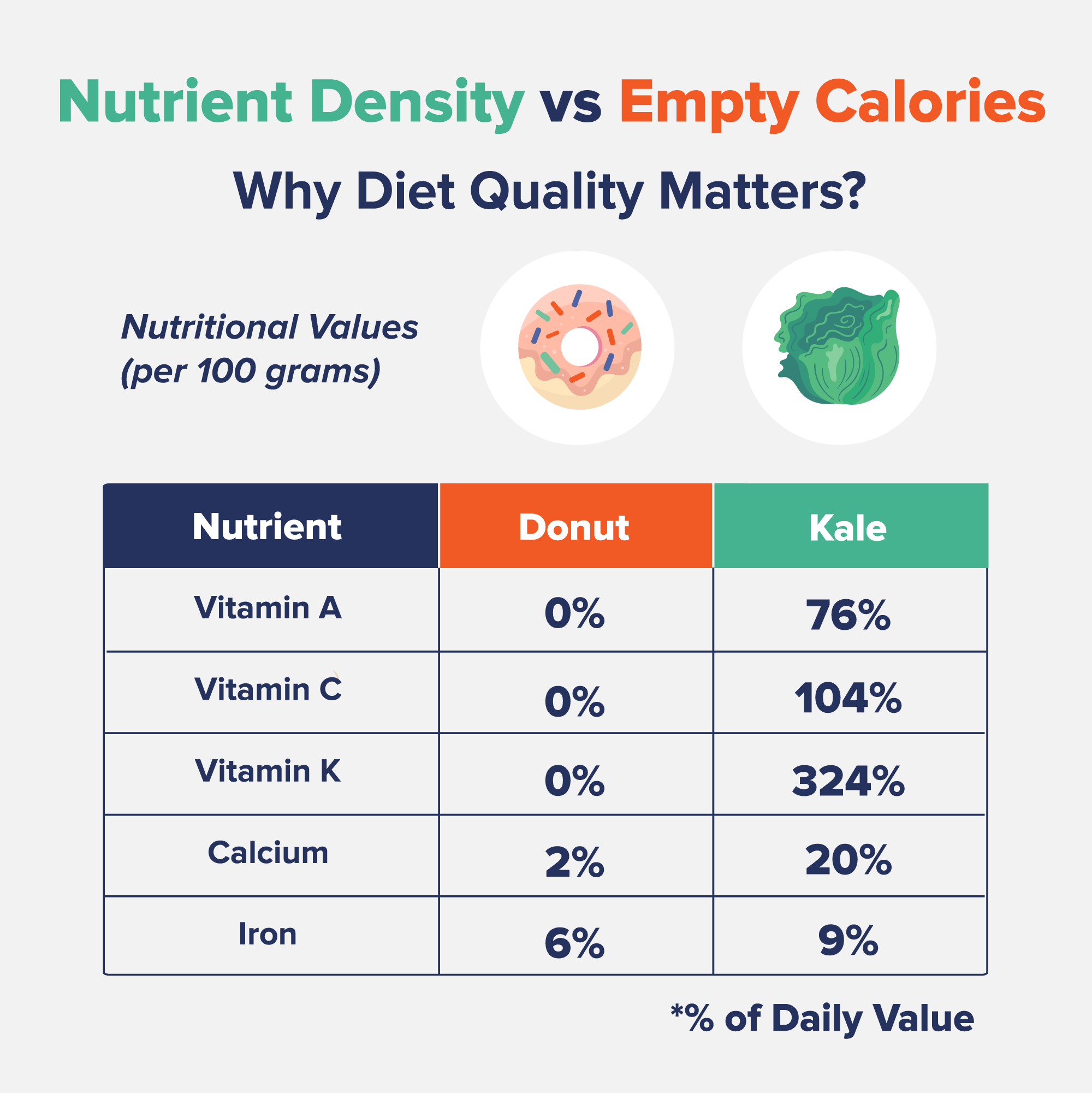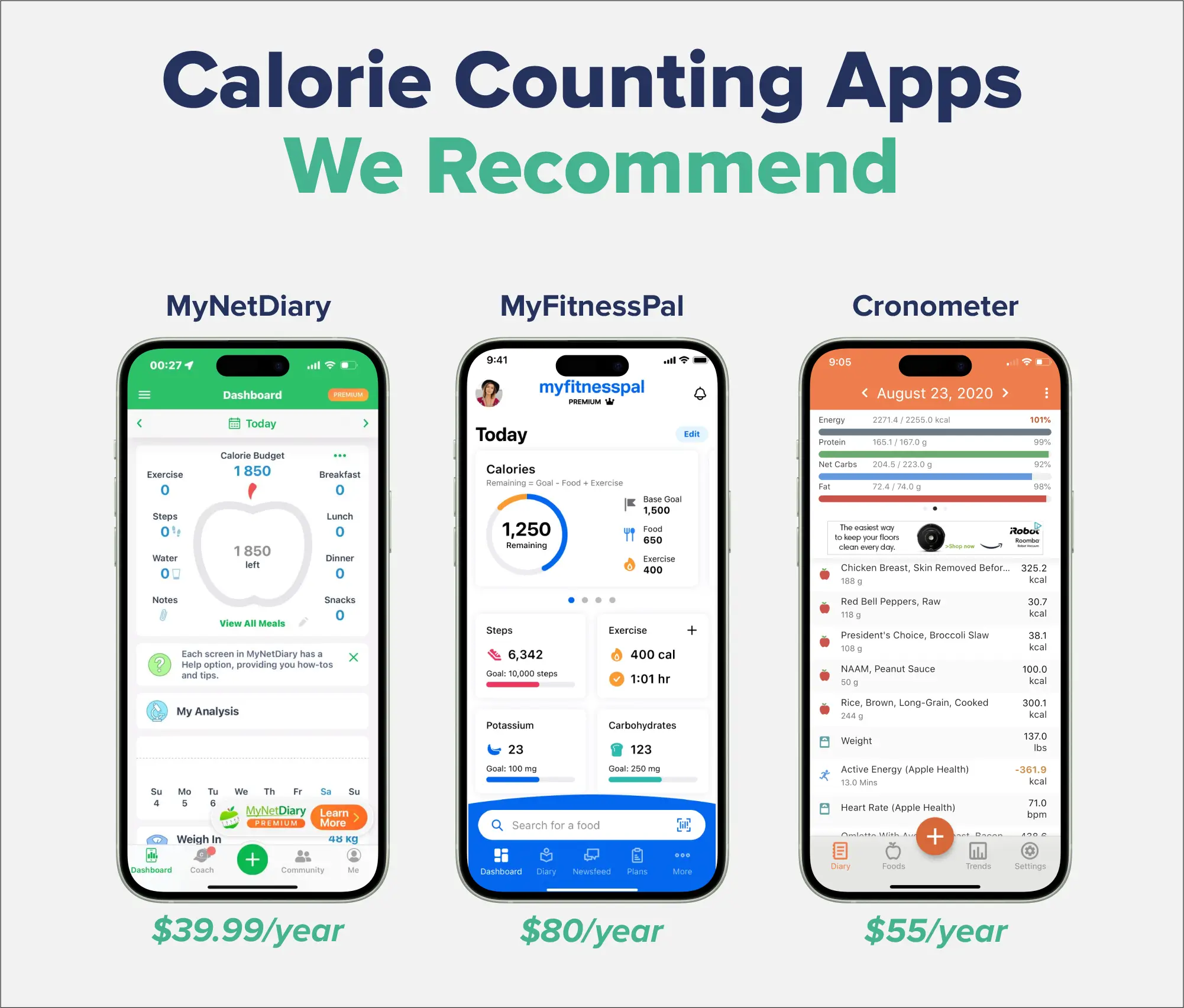Save $40 on your initial consult with a TNI Dietitian!
Talk to a real Dietitian for only $99: Schedule Now
This post contains links through which we may earn a small commission should you make a purchase from a brand. This in no way affects our ability to objectively critique the products and brands we review.
Evidence Based Research To fulfill our commitment to bringing our audience accurate and insightful content, our expert writers and medical reviewers rely on carefully curated research.
Read Our Editorial Policy
Knowing the calorie content of what you eat and drink—and how much of it you consume—can improve your overall health by making you more aware of what you’re putting in your body.
However, tracking calories is not as easy as it seems, and it’s certainly not the only factor that affects weight gain or loss.
Fortunately, many apps can now help you on your weight loss journey by providing more than just a calorie count—they can also help you learn about diet quality, keep you on track with macros, and teach you about portion sizes.
In this article, we’ll discuss the best practices for using a calorie-tracking app to lose weight and general tips beyond calorie counting to help you on your health journey.
In theory, weight loss involves eating fewer calories than you use, which creates a calorie deficit. However, losing weight depends on so many factors above and beyond a calorie deficit, including diet quality, nutritional status, gut health, metabolic health, activity level, toxin exposure, sleep, stress, age, muscle mass, genetics, hormonal changes, medications, and the list goes on.
Because of these myriad factors, the recommendation to just “eat fewer calories” doesn’t always apply to everyone.
Plus, eating significantly fewer calories can often lead to undesirable hormonal changes that end up stimulating appetite, reducing metabolic rate, and causing overeating of high-calorie or hyperpalatable foods.1
That said, many people can benefit from learning about the number of calories in the foods they eat, what portion sizes actually are, and how many calories your specific body needs each day to function.
Even if you don’t use a calorie-tracking app long-term, sticking to it for a month or so can help you gain more awareness and understanding of what you eat. For example, you may learn that you don’t really want to use up 300 of your calories by overdressing your salad or cooking with too much olive oil or that those three glasses of wine on Friday night aren’t serving you. For a more in-depth look at the “calories in, calories out” philosophy, check out this article. Now, we’ll dive into the best practices for using calorie-tracking apps to help you lose weight.
One thing many people get wrong about counting calories is accuracy. This is understandable, as it can be hard to judge whether you just poured in a tablespoon or two of your salad dressing without measuring it.
The best and most accurate way to determine how much you are eating is to weigh your food with a food scale. However, this can be time-consuming and not always practical (for example, if you’re out to eat or at a friend’s house).
If you are at home and have a few extra minutes, weighing the amount of chicken you’re putting on your plate first can help improve the accuracy of your calorie counting.
After all, if you’re not being accurate with what you’re putting into your calorie tracking app, it really can’t help you.
If you don’t want to use a food scale, practice using measuring cups and spoons at home until you get a pretty good idea of how big or small certain portions are.
A less accurate way to “measure” food is eyeballing it with comparisons. For example, one serving of cheese (1.5 ounces) is considered to be the size of a lipstick tube. Here are some other common comparisons:

Research shows that people can underestimate how much they eat by as much as 47%, which can obviously play a significant role in whether or not you lose weight.2
Being accurate and truthful is probably the most important thing you can do to be successful at counting calories for weight loss.
Once you get better at visualizing portion sizes or measuring them at home, you’ll also be better able to accurately track calories from restaurants or food not prepared by you.
Becoming proficient at reading a food’s nutrition label can also help you better use calorie-tracking apps for weight loss. This is partly due to accuracy—for example, if you aren’t aware that the bag of chips you just ate has 2.5 servings in it instead of just 1, you won’t be able to track it accurately.
But reading and learning about nutrition labels can also help you make better choices when you’re at the grocery store, which is a proactive step for weight loss because you won’t have less nutritious food around the house. Learn more in this in-depth article about how to read food labels, how to know if a food is healthy, and what ingredients to watch out for.
In terms of caloric value, 100 calories of kale is the same as 100 calories of Krispy Kreme. However, their nutritional value and impact on your body are vastly different, which can affect your weight.
Foods with high nutrient density—meaning they have a lot of nutrients for their calorie count, like fresh fruits, vegetables, seafood, eggs, avocados, and nuts—affect your metabolism, hormone levels, hunger, and appetite differently than less nutrient-dense, ultra-processed foods.
For example, those 100 calories of Krispy Kreme donuts will not make you feel satiated and can cause significant blood sugar spikes, leading to overeating a few hours later and dysregulated metabolic health over time.
Therefore, while it may seem like “a calorie is a calorie is a calorie,” when it comes to overall health, diet quality matters.

Aim to eat a balanced and healthy diet full of fresh fruits, vegetables, herbs, legumes, beans, seafood, lean meat, dairy (if you like), and fiber-rich, minimally processed whole grains like quinoa or farro most of the time—but, of course, fitting in Krispy Kreme every once in a while is okay, too.
Many calorie-counting apps do not consider diet quality, but one of our favorites, MyNetDiary, does. The following sections will provide more details about MyNetDiary and other calorie-tracking apps.
Many people find weight loss success on a moderately lower-carb and higher-protein diet.
Most calorie tracking apps can track macros (meaning macronutrients, or the percentages of carbs, fat, and protein you eat) for you, and they will automatically set them for you based on your goals of weight gain, loss, or maintenance.
Although it can vary widely from person to person, macro ratios for weight loss might be: 20-40% of your daily calories from carbohydrates, 30-40% from protein, and 30-40% from fat.
Some people find success on lower-carb diets (such as keto), which restricts carbohydrates to 5-10% of calories.
Elevating protein intake may be particularly helpful for weight loss, as it’s highly satiating, reduces hunger hormones, and increases the number of calories you burn while digesting it more than other macronutrients.
In a meta-analysis of 24 randomized controlled trials of overweight or obese people, those who followed a high-protein diet (27-35% of daily calories as protein) had a greater reduction in body weight and fat mass with preserved lean body mass compared to those eating 16-21% of their calories as protein. Specifically, 12 weeks of eating higher protein led to an average loss of 2 pounds of fat mass.3
If you aren’t finding success with simply counting calories, you could try sticking to macro ratios that a calorie tracking app (like Cronometer, MyFitnessPal, or MyNetDiary) recommends for you to achieve healthy weight loss.
A healthy lifestyle is not just about eating well—it also must include exercise or physical activity. One of the best (and free) ways to exercise is by taking daily walks. Although it varies individually, walking one mile burns about 100 calories. Research shows that taking two shorter walks (25 minutes) per day may lead to more weight loss than one longer (50-minute) walk.4
If you can do more intense exercise than walking, lifting weights or strength training is an excellent way to change your body composition. However, you might see less movement on the scale, as you may be gaining muscle while losing fat (an ideal scenario).
In a 2022 meta-analysis of 114 trials, researchers concluded that interventions combining resistance training and calorie restriction were the most effective for reducing body fat percentage and whole-body fat mass.5
Most calorie-tracking apps can sync with fitness trackers (like Apple Watch, Fitbit, Garmin, or Oura Ring) and update your caloric needs for that day in real time. If you don’t have a fitness tracker, you can manually input any exercise you did (be accurate!) to see how your calorie needs change for that day.
Lastly, you do not want to severely restrict your calories. Even if you think it will help you reach your weight loss goal faster, it will likely backfire. Many people who lose weight rapidly will gain all or most of it back, and their metabolisms can significantly slow down, too.
This has been studied in people who went on The Biggest Loser show. Although they lost significant amounts of weight, most people gained most of it back within the next six years and had slower resting metabolic rates by an average of 700 calories from when they started.6
Therefore, a slow and steady approach to weight loss is likely more effective. Plus, it will be a more sustainable weight loss “diet” because you hopefully won’t feel like you are depriving yourself.
Aiming for a weight loss of 0.5-1 pounds per week (up to 2 pounds per week if you have more weight to lose) is a reasonable goal.
Your calorie-counting app can set this for you automatically. Although you may see an option for weight loss higher than 1-2 pounds per week, we recommend sticking to a “slow and steady” amount.
There are many potential reasons why you are not seeing weight loss when you count calories.
First, you may be underestimating how many calories you are eating (or overestimating how much exercise you are doing). Be sure to input accurate portion sizes, and don’t forget about things like beverages, coffee creamer, cooking oils, sauces, and dressings.
Second, you may be within your calorie range for weight loss but have poor diet quality, which could increase your hunger hormones, cause nutrient deficiencies that are needed for metabolic function, or cause constant blood sugar spikes that lead to your body storing excess sugar as body fat.
Third, you may be eating macronutrient ratios that are too high in a particular macronutrient (usually carbohydrates). You could attempt a moderate-carb, higher-protein, moderate-fat diet. Fourth, if you are exercising (especially strength training), you may be gaining muscle, which may not show up as weight loss on the scale.
Lastly, many other things can affect your body weight, including fluctuating hormone levels (especially during perimenopause and menopause), high chronic stress, poor sleep patterns, menstrual cycle fluctuations, water weight (retained water from excess salt or medications, for example), or chronic undereating which slows your metabolic rate (meaning you don’t burn as many calories as you used to).
Cost: $80/year, $20/month, or basic version for free
The most well-known calorie-counting app for a reason, MyFitnessPal has an extensive food database and user-friendly interface. Most of the app can be accessed in the free version, but special features—like a barcode scanner, zero ads, and custom macro tracking—are in the Premium subscription. MyFitnessPal has 14 million foods in its database, but many of them are uploaded by users. This means that the accuracy of some foods can be hit or miss. You can get verified entries by looking for ones with a green checkmark.
This app is great for counting calories, and many people use it for weight loss, as it calculates your recommended daily calorie intake based on your weight loss goals. The main page of the app tells you how many calories consumed during the day, the remaining number of calories to consume, and how many calories burned by exercising, making it easy to see how many you have left that day.
Cost: $39.99/year, $8/month, or basic version for freeMyNetDiary is an excellent choice for a calorie counter app focusing on diet quality. The app gives your meals a letter-grade scoring system based on how a nutrition expert would score the food’s nutritional quality. The app’s interface is intuitive and user-friendly, with cute images of food. You can also use the barcode scanner or search their “popular foods” or “staples” sections. The app fully customizes your daily calorie target (and macros), provides daily nutrient and meal analysis to help you learn more about healthy eating, and has an extensive community area.
Cost: $55/year, $10/month, or basic version for free
If you are very into counting macros or have specific dietary needs (like keto), Cronometer is another good option. It’s a little more technical-looking than MyNetDiary (no cute emojis), but many prefer that style.
Cronometer has a more complete and detailed nutrient summary for each food than most other apps. For example, each food’s content of caffeine, alcohol, omega-3, omega-6, trace minerals, and essential amino acids is listed (in addition to the standard macronutrients and more common vitamins and minerals).

While there are plenty of benefits of tracking your calories and food, there are also some potential downsides to be aware of.
Anyone with an eating disorder or a history of disordered eating should avoid using calorie trackers, as the apps can make you more likely to engage in disordered eating behaviors again.
Even if you’ve never had an eating disorder before, it’s essential to keep an eye on how you feel when you use calorie tracker apps. For example, do you start to feel obsessive about tracking food and closely monitoring everything you consume? Do you start trying to over-exercise to ensure you don’t go over your calorie count for the day?
If you start skipping meals, feeling guilty about your food choices, being overly preoccupied with what you eat, or being obsessive about any part of calorie counting, it’s time to take a break. You can also speak with a Registered Dietitian specializing in eating disorders or chat, call, or text with trained volunteers at the National Eating Disorders Association helpline for free.
This will vary individually based on age, height, sex, and activity level. Online calorie calculators can help you determine how many calories you should eat daily for weight loss. Calorie-tracking apps, like MyNetDiary and MyFitnessPal, can also calculate this for you.
One of the most essential things for calorie counting is getting more accurate with portion sizes. If you underestimate what you ate or drank, it will be more challenging to lose weight because you’ll think you’re in the correct caloric range when you are not. Using a food scale or measuring cups can help to increase your accuracy. Don’t forget about oils you used to cook with, dressings, sauces, and calorie-containing beverages like alcohol, coffee drinks, or juice.